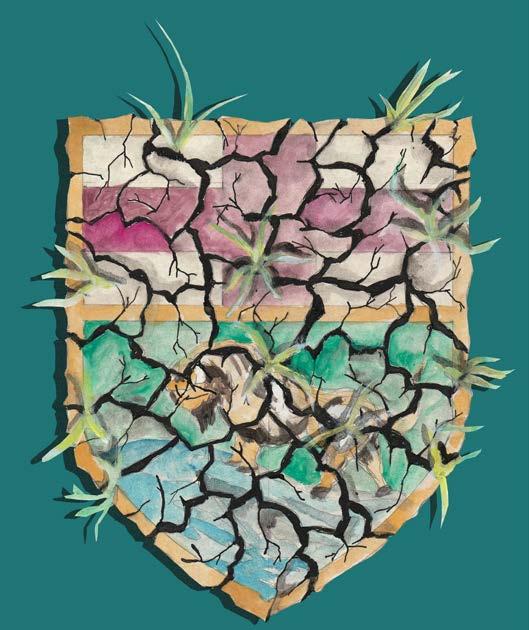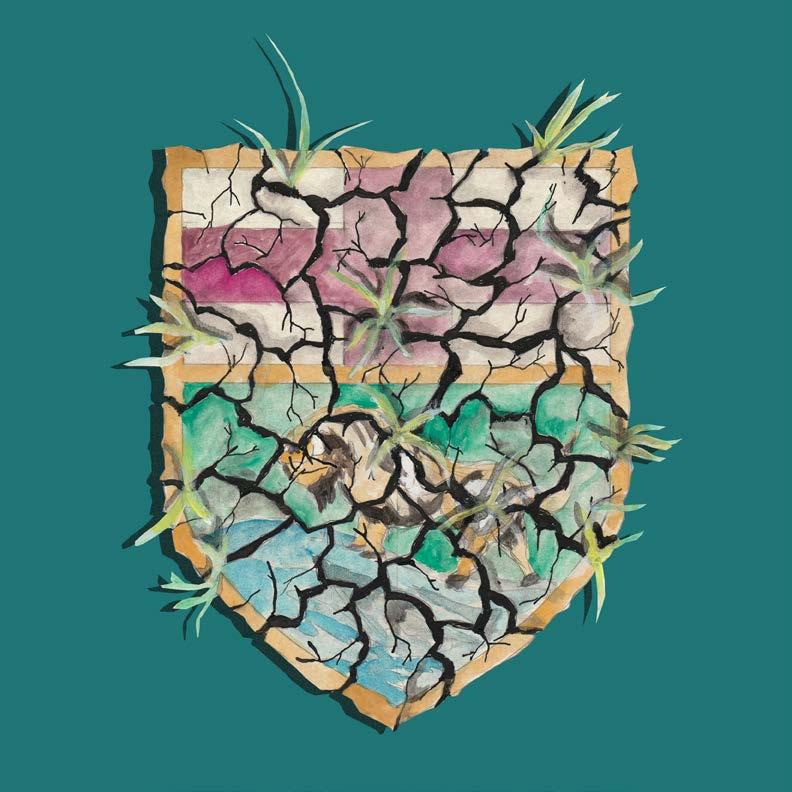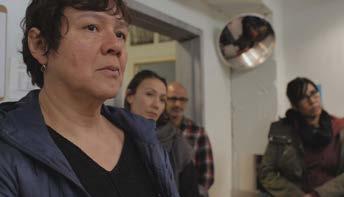
8 minute read
Comment pages 10 to
Drought signals need for sustainable agriculture
Climate challenges lie ahead, but governments can reduce risks by investing in food
COMMENT
Lucas Edmond, staff As Winnipeggers funnel into airconditioned buildings to stave off record-breaking heatwaves, Manitoba’s farmers are facing a much deeper crisis.
For avid small talkers who love to discuss the weather, the low river and empty floodways during flood season were the first indications that Manitoba was going to have a summer of extreme conditions. Then the aphids appeared — a small insect that thrives in hot, dry weather — lathering Winnipeg’s canopy with sticky gunk. Finally, reality of the drought’s devastation struck when the West Coast of North America erupted in flames following a heatwave that stretched across several borders earlier this summer.
On July 5, just days after the heatwave, St. Laurent, Man. declared an agricultural state of disaster as potential crop yields continued to dwindle in the face of high aridity and soil exhaustion. Armstrong, Man. was the second rural municipality to declare a state of agricultural disaster on July 9, but it is likely not the last.
As Manitoba’s farmers fight to stay afloat with the support of only 40 per cent of Manitoba’s natural rainfall, a grasshopper infestation — produced by the dry conditions — has begun eating away at the limited vegetables, grains and oats farmers have managed to grow.
Due to the heat and the grasshoppers, a significant portion of crops that are often recycled as feed for cattle have been lost. Many farmers are being forced to cut their losses and sell their herds. Some have decided to prematurely cut their crops to bundle their feed in order to keep their livestock through the winter — forcing them to lose large portions of their annual incomes.
The ecological disaster and its consequential financial impact has stimulated discussions with the provincial government about financial aid to keep the province’s large agricultural sector healthy. However, subsidies for lost incomes should go a step further.
Although droughts have been prevalent across North America throughout the 21st century, this year is shaping up to be the driest in the last century. Record-breaking heat and inconsistent rain due to global warming — compounded by exhaustive industrial agriculture — are destroying the soils, stripping them of nutrients at a rate incomparable to any other period in modern history. Humanity and our methods of production, accumulation and distribution has spurned a new geological epoch now visibly discernable in the stratigraphic record. If the weather continues to become increasingly unpredictable due to our ecological impacts, then something must be done to create a more sustainable and predictable agricultural sector.
The provincial government should take time to consider the benefits of establishing a fund dedicated to farmers who want to transition their efforts away from the unsustainable methods of industrial monoculture cropping that have proven to be unstable during this perilous drought. Although much more expensive and labour intensive, permaculture cropping adopts a land management system dedicated to farming based on a balanced ecosystem that can thrive through tough environmental conditions without the assistance of expensive and detrimental inputs of herbicide, pesticide and artificial fertilizer.
In other words, instead of planting one cash crop that is easy to harvest but tough on the environment, the agricultural sector should look toward planting crops and vegetation that mutually complement each other in their ecological contexts.
Monoculture industrial farmers typically try to avoid using pesticides due to their damaging effects on the ecosystems that surround their plots. However, if the dry conditions and the infestations persist, many farmers — without the capacity to produce natural solutions to the crisis — may have to bite the bullet to protect their livelihood in the short term.
As many biologists from around the world have concluded, killing back pests with artificial products stunts local ecology and the environment’s natural ability to balance itself. Using pesticides kills off vital food sources for various predators, thus unintentionally killing various other species and reproducing the conditions for much worse infestations in the future. Destroying biodiversity is exactly what farmers need to avoid during these periods of agricultural crisis. drought, farmers will be investing in the longevity of their yields while simultaneously reducing their industrial emissions. Transitioning into a labour-intensive permaculture system will be a crucial step in making the future of the planet green, but the transition must start with incentives and funding from federal and provincial coffers.
Fundamentally, it is up to farmers to make their decisions in conjunction with government bodies. However, the world is not fixing itself, and sustainable agriculture is a good first step at mitigating the public calamities that lie ahead.
staff Dallin Chicoine / graphic /

An exploration of history, identity and culture
Winnipeg-based filmmakers discuss what it means to be Jewish in Manitoba
ARTS & CULTURE
Shaylyn Maharaj-Poliah, staff Local filmmaker and U of M alumna Sara Bulloch is premiering her latest short documentary film, Ma Nishma Manitoba, at the 21st annual Gimli Film Festival (GFF). Codirected with fellow Winnipeg-based filmmaker Johanna Reimer-Henteleff, Ma Nishma Manitoba is an honest and intimate exploration of what it means to be a Jewish person in Manitoba. Bulloch and Reimer-Henteleff examine their own experiences with those of other Jewish Manitobans using interviews, illustrations and stop-motion animation.
Ma Nishma Manitoba is part of a new collection of short films titled Friendly Manitoba. The literal Hebrew translation of the documentary’s title “Ma Nishma” is “What do you hear?” which is a common greeting used to ask “What’s new?”. Originally commissioned by the GFF in late 2019, the octet of films showcases the province’s diversity told through the perspectives of various local filmmakers.
The 43-minute film provides many perspectives of the Jewish identity, as told by both directors and their numerous subjects ranging from a rabbi, an artist, an Israeli immigrant and more. Each person’s experiences are supplemented by family photos and archived news articles relating to each topic of conversation.
The information presented is plentiful and fast-paced, moving seamlessly from general Jewish experiences to more specific accounts, such as fulfilling mandatory military service abroad and attending the Winnipeg Hebrew Free School, the building which is now a Manitoba historical site. The documentary provides the perfect balance of history, lived experience and storytelling.
The directors bring their viewers into the film by contextualizing historical images with present-day footage. This is achieved by using match cuts of historical photos of Winnipeg and their modern counterparts. This provides a holistic, educational and thorough approach to the subject matter as exemplified by their onscreen definitions of words that their audiences might not be familiar with, such as “Shabbat,” “sukkah,” “mensch” and others.
The film is playful, but it does not shy away from some of the more serious issues faced by the Jewish community. Bulloch and Reimer-Henteleff make space to discuss the history of antisemitism in Manitoba and racism within the Jewish community. They also make a point to touch on the ongoing conflict between Israel and Palestine and tackle all these issues carefully, gracefully and respectfully.
Just before the credits roll, Bulloch and Reimer-Henteleff briefly speak on their experience creating the piece.
“I’m just grateful that we did this,” said Bulloch.
“It’s definitely a reconnection point for me,” said Reimer-Henteleff. “It’s nice to be able to be a part of a project that maybe someone can learn something [from], either about themselves or about the community and maybe help someone feel less alone so they feel more welcome to open up to someone.”
provided Sara Bulloch / photo /

Bulloch concurred.
“And it can apply to so many cultural groups.”
At its core, Ma Nishma Manitoba is a film about connectedness, history, family, community and identity. It is about finding who you are through your culture and finding things within your culture that resonate with you.
Ma Nishma Manitoba is available to view for free until July 25 on gimlifilm.com.
arts@themanitoban.com
Moving forward with understanding and empathy
New documentary film examines substance use among Indigenous people
ARTS & CULTURE
Shaylyn Maharaj-Poliah, staff Kímmapiiyipitssini: The Meaning of Empathy, the debut work from Seen Through Woman Productions, is currently screening at the 2021 Gimli Film Festival (GFF). Written and directed by Blackfoot and Sámi filmmaker ElleMáijá Tailfeathers and co-produced by the National Film Board of Canada, the documentary paints an intimate picture of the fentanyl crisis that has plagued the Kainai First Nation in southern Alberta since 2014. It shows the steps being taken to help heal the community and change their approaches to addiction and recovery.
Prior to its showing at the GFF, Kímmapiiyipitssini: The Meaning of Empathy generated a buzz at the 2021 Hot Docs Canadian International Documentary Festival in Toronto, Ont. and the DOXA Documentary Film Festival in Vancouver, B.C., being the recipient of three awards between the two festivals, including the Colin Low Award for Best Canadian Director.
Candidly, but delicately, the documentary profiles members of the community who are struggling with substance abuse as well as frontline workers and medical professionals — like Esther Tailfeathers, the director’s mother — who are actively implementing harm reduction strategies to save lives.
The film is narrated by director Tailfeathers, who eloquently makes the correlation between settler colonialism, generational trauma and the use of harmful substances, including alcohol and inhalants. She also describes the pushback from people in the cities who believe in abstinence programs over harm-reduction initiatives like supervised injection sites.
While Kímmapiiyipitssini: The Meaning of Empathy is a slow-moving film, the pacing is not detrimental to its quality. In fact, it provides the space for reflection on the part of the viewer.
This is not an easy film to watch, but it is a necessary one. Despite the heavy subject matter, Tailfeathers approaches these subjects gently, tactfully and without judgment. By examining Canada’s legacy of trauma and the ongoing effects of historical injustices, she invites her audience to begin to understand the struggles that Indigenous people face.
In light of the recent, tragic discoveries uncovered at several residential schools across the country, this understanding is even more critical and urgent in supporting the healing of the pain and suffering of colonialism which continues to impact lives today.
The film’s tone is reflected in its title — “kímmapiiyipitssini” is a Blackfoot word that means “giving kindness to each other.” The film shows that treating addiction through empathy, compassion, kindness and
/ provided photo / NFBC

understanding puts humanity first and provides hope for the future.






